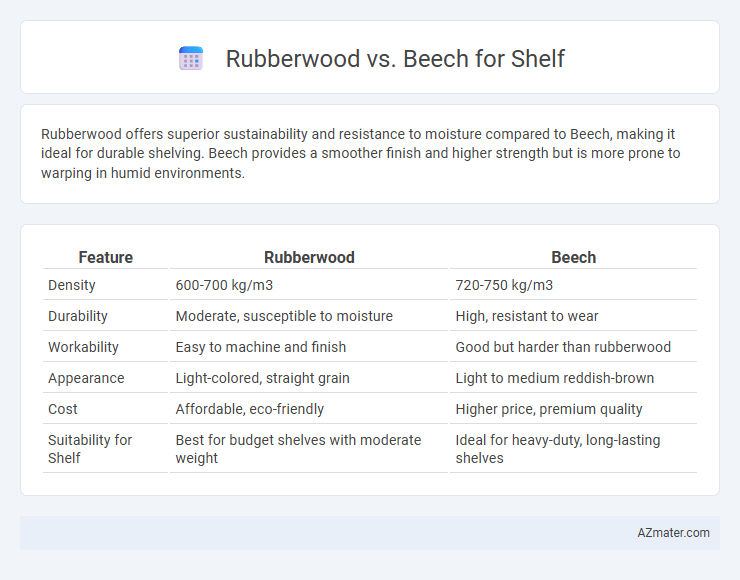Rubberwood offers superior sustainability and resistance to moisture compared to Beech, making it ideal for durable shelving. Beech provides a smoother finish and higher strength but is more prone to warping in humid environments.
Table of Comparison
| Feature | Rubberwood | Beech |
|---|---|---|
| Density | 600-700 kg/m3 | 720-750 kg/m3 |
| Durability | Moderate, susceptible to moisture | High, resistant to wear |
| Workability | Easy to machine and finish | Good but harder than rubberwood |
| Appearance | Light-colored, straight grain | Light to medium reddish-brown |
| Cost | Affordable, eco-friendly | Higher price, premium quality |
| Suitability for Shelf | Best for budget shelves with moderate weight | Ideal for heavy-duty, long-lasting shelves |
Introduction: Rubberwood vs Beech for Shelving
Rubberwood offers a sustainable and cost-effective option for shelving with its medium density and resistance to warping, making it suitable for everyday storage needs. Beech wood, known for its hardness and fine grain, provides superior durability and a smooth finish ideal for high-quality, long-lasting shelves. Both woods are popular choices, but Beech tends to be preferred for premium applications while Rubberwood excels in eco-friendly and budget-conscious projects.
Overview of Rubberwood and Beech
Rubberwood, derived from the Para rubber tree, is a sustainable hardwood known for its light color, durability, and affordability, making it a popular choice for shelving. Beech wood, a dense and strong hardwood native to Europe, offers a smooth grain, pale cream color, and excellent wear resistance ideal for high-quality shelves. Both woods provide sturdy support but differ in texture, with rubberwood presenting a more porous surface and beech offering a tighter grain structure.
Durability and Strength Comparison
Rubberwood offers moderate durability and strength, making it suitable for lightweight to medium load shelves, but it is prone to dents and scratches over time. Beech wood excels in strength and hardness, providing superior durability that supports heavier loads without compromising structural integrity. When choosing between Rubberwood and Beech for shelving, Beech is the preferred option for high-strength, long-lasting performance.
Appearance and Grain Differences
Rubberwood features a light, creamy color with a subtle, straight grain that lends a clean and uniform appearance ideal for modern shelving. Beech displays a slightly darker, reddish tint with a fine, tight grain pattern distinguished by occasional small flecks and waves, offering a richer, more classic look. The contrast in grain intricacy and color between rubberwood and beech significantly influences the aesthetic appeal and style suitability of shelves crafted from these hardwoods.
Weight and Workability
Rubberwood is lighter and easier to work with compared to beech, making it ideal for shelves that require frequent adjustments or modifications. Beech wood is denser and heavier, offering superior strength and durability for heavy-duty shelving but can be more challenging to cut or shape. Choosing between rubberwood and beech depends on the balance of weight capacity and ease of fabrication needed for your project.
Cost and Availability
Rubberwood offers a cost-effective option for shelves, benefiting from its status as a byproduct of the rubber industry, resulting in widespread availability and lower market prices compared to Beech. Beech wood, prized for its dense grain and durability, commands a higher price and tends to be less readily available, particularly in regions without extensive European or North American hardwood supplies. Shelf projects aiming for budget efficiency typically favor Rubberwood due to its accessibility and competitive pricing, while Beech is chosen for premium, long-lasting applications despite higher costs.
Environmental Impact and Sustainability
Rubberwood is a highly sustainable choice for shelving due to its origin from rubber trees after latex production ends, reducing deforestation and waste. Beech wood, while durable, often comes from slower-growing trees requiring longer harvesting cycles, which can contribute to habitat disruption and higher carbon emissions. Choosing rubberwood shelves promotes a circular economy by repurposing plantation byproducts, significantly lowering environmental impact compared to traditional hardwoods like beech.
Maintenance and Lifespan
Rubberwood shelves require regular cleaning with a damp cloth and should be kept away from excessive moisture to prevent warping, offering a lifespan of around 10 to 15 years with proper care. Beech shelves are more resistant to wear and scratches, needing minimal maintenance such as dusting and occasional oiling, and can last up to 20 years or more in ideal conditions. Both woods benefit from controlled humidity environments to enhance durability and maintain their structural integrity over time.
Suitability for Different Shelf Types
Rubberwood is ideal for budget-friendly, lightweight shelves due to its moderate durability and natural resistance to warping, making it suitable for decorative or storage shelves. Beech, with its higher density and strength, is better suited for heavy-duty shelving such as bookcases or industrial storage units where load-bearing capacity and long-term stability are critical. Both woods offer smooth finishes, but beech provides superior hardness and resilience for shelves exposed to frequent use or heavy loads.
Final Verdict: Choosing the Best Wood for Shelves
Rubberwood offers sustainability and affordability, making it ideal for eco-conscious shelf builders, while beech provides superior hardness and durability for heavy-duty use. Both woods feature a fine, smooth grain suitable for a polished finish, but beech resists dents and scratches better over time. For shelves requiring long-lasting strength and smooth aesthetics, beech is the optimal choice, whereas rubberwood suits budget-friendly, moderate-load applications.

Infographic: Rubberwood vs Beech for Shelf
 azmater.com
azmater.com